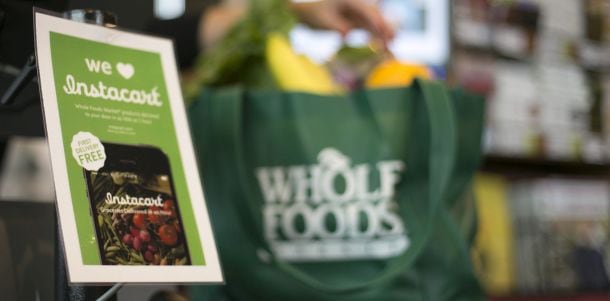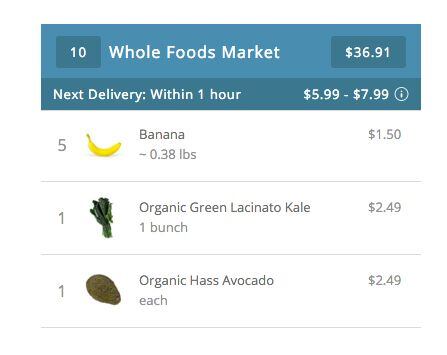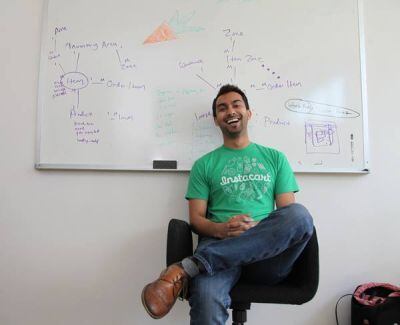Suzy Monford was speaking to FoodNavigator-USA after Andronico’s notched up its first $1million in InstaCart sales, the vast majority of which were incremental (ie. additional baskets from existing customers, or new customers), she claimed.
“For us it’s probably 95% or more incremental business [the service – which Andronico’s started rolling out in August 2015, is now available from four of its five stores]. We’re doing sales in zip codes where we have no stores. InstaCart says that nationwide their average basket is around $80 and I’d say we are spot on that. The basket size is also double our average basket, so people are spending more online and then augmenting that with their bricks & mortar shopping.
“Generally the profile [of an InstaCart basket] is about 20% produce, 10-15% meat and then bakery and center store take up the rest, but we also see that people are using it a lot to shop for parties, so you will see things like fresh shrimp and lots of bottles – you can tell people are getting ready to entertain, and the InstaCart service is great for that.”
This is not a trend, it’s not a fad, it’s part of the way people are shopping now
She added: “When I became CEO (last summer) I felt we really had to hurry up and get caught in digital, and I say to people if you’re not doing this, you should smack yourself in the head, as this is not a trend, it’s not a fad, it’s part of the way people are shopping now.”
“Look at what Whole Foods is doing [according to press reports, Whole Foods – which has been working with InstaCart for some time - is now investing in InstaCart as well]. This way of shopping is very convenient and it’s becoming part of people’s lifestyles. It’s not that people are stopping being bricks and mortar shoppers, but they are using InstaCart as their lifeline for when they are busy, or entertaining, or whatever.”
“At approximately 3% of company wide sales, Instacart’s on-line platform is helping us reach Andronico’s fans all over the Bay Area, including Oakland, Emeryville and the entire city of San Francisco—areas well outside our brick and mortar parameters.”
Bridget Kwok, marketing director, Andronico’s Community Markets
InstaCart offers innovative retailers an opportunity to get their share of digital food spending
But are there any potential downsides to partnering with InstaCart, particularly the risk of losing a direct connection/interaction with your end customer, plus the fact that InstaCart shoppers don’t impulse buy as they are not shopping for themselves, but from someone else’s list?
Of course there are risks, said Monford, but for Andronico’s at least, they have been more than offset by the benefits. “I think InstaCart offers innovative retailers an opportunity to get their share of digital food spending just as they have got their fair share of bricks and mortar retailing by offering exclusive, distinctive products.”
While there is an ‘existential’ risk from losing the direct, face-to-face relationship with your end customer, meanwhile, she said, “there are other ways to engage with your customers online, so we still have a relationship.”
As to how much business retailers such as Andronico’s could ultimately do via InstaCart, Monford said it was still too early to say, as many people were still discovering the service, which it has been progressively rolling out to its stores since last August.
But she added: “We have yet to reach elasticity, and as InstaCart continues to offer additional services we expect the numbers to grow.”

How does InstaCart work?
A high-profile player in the on-demand economy (think Uber and Airbnb), Instacart was founded in San Francisco in 2012 now operates in hundreds of cities in more than 19 states.
The platform enables consumers to order groceries online via a web app from stores such as Andronico’s and Whole Foods, by activating an army of ‘personal shoppers’ to pick the orders from stores and deliver them to consumers’ door in their own vehicles – sometimes within the hour.
Like Uber (which doesn’t own any cabs) Instacart does not buy, build or maintain its own stores, warehouses or trucks, but serves as a conduit between existing stores, consumers, and personal grocery shoppers (who - like Uber drivers - are classified as independent contractors rather than employees).

So how does it make money?
According to a spokesperson we contacted: "We collect revenue through revenue share by retail partners on our platform, advertising revenue from CPG brands, and delivery fees."
Asked whether there is a markup on the products sold through the InstaCart platform, she said: "Close to two thirds of retailers on our platform have price parity."
The consumer pays a delivery fee (starting at $5.99 in most cities) per transaction or they can pay an annual membership fee to join Instacart Express and get free deliveries on all 2-hour and scheduled deliveries over $35).
What are the risks for bricks & mortar retailers of partnering with InstaCart et al?
What is not clear at this stage is how disruptive platforms such as InstaCart will ultimately be to the food retailing landscape, Barb Stuckey, chief innovation officer at leading product development consultancy Mattson, and a regular user of InstaCart, told FoodNavigator-USA.
But if they start to displace a significant amount of shopping trips, the impact could be profound, she said.
“InstaCart shoppers are not shopping the store in the same way. They are not influenced by end caps and instore demos, and they don’t make impulse purchases, so the tools that retailers and manufacturers have traditionally used in stores to get shoppers’ attention will become less and less effective. It’s basically making stores more like distribution centers.”
“Our Instacart sales continue to grow nicely, and we now offer delivery in 16 markets, with many stores seeing sales as a percentage of total store in the mid-to-high single digits and several stores averaging baskets over $100. We are in the process of expanding the service to more stores and several new markets this year.”
Whole Foods Market co-CEO Walter Robb, February 2016 (Q1 earnings call)
It’s basically making stores more like distribution centers.”

Longer term, she added, retail brands that partner with InstaCart could also find that their brands become less prominent on the InstaCart platform (which enables consumers to order from multiple stores in an area).
“For me, for many of the products I order on InstaCart, I don’t really care which store they are from and I find myself paying less attention to the retail brand.”
The customer relationship, she adds, is with InstaCart, not the retailers it’s partnered with.
“What I also like about it is the fact that if they can’t find what you’ve ordered, they [the personal shopper assigned to your order] can text you asking about substitutions. The user experience is very good.”
